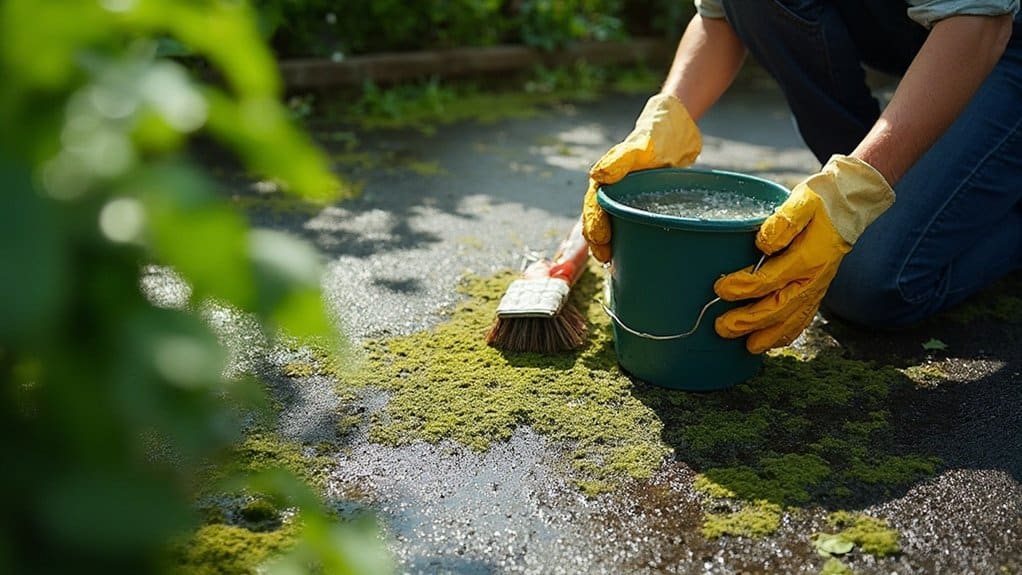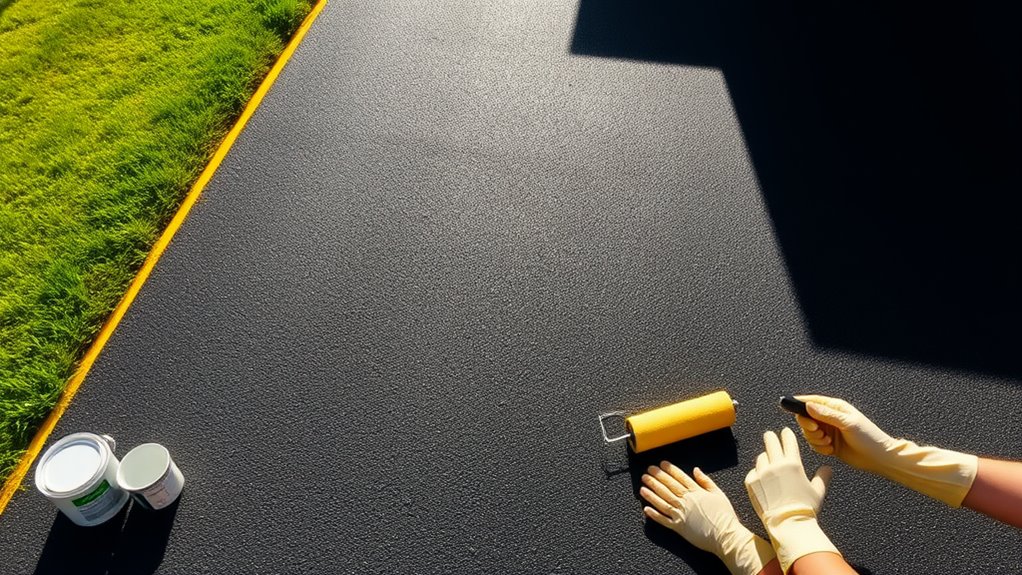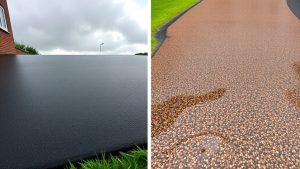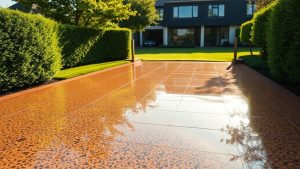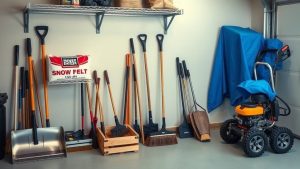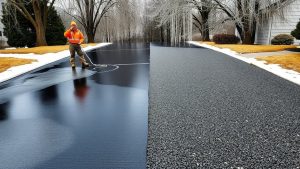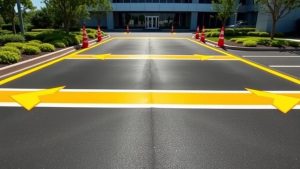To remove moss and algae from your tarmac driveway, start by scrubbing the affected areas with a stiff broom or wire brush. For stubborn growth, consider using a commercial moss killer like Batiface or a diluted bleach solution. If you prefer eco-friendly options, baking soda can be effective, or you might try pressure washing with a 40° nozzle for thorough cleaning.
Ensure that vegetation is trimmed back to allow sunlight to reach the surface and promote proper drainage. For more tips on effective cleaning methods and preventative measures, keep reading on this topic.
Table of Contents
ToggleKey Takeaways
- Remove moss and algae by scraping them off with wire brushes and stiff brooms, wetting the surface first to make it easier.
- Use commercial moss killers or eco-friendly options like baking soda to effectively clear growth on your tarmac.
- A pressure washer can be handy; just use the right nozzle, keep a safe distance, and clean in sweeping motions for an even finish.
- Regularly trim back overhanging trees and clear out drains to let in more sunlight and reduce moisture.
- To keep your driveway moss-free, apply moss inhibitors and sweep regularly.
Causes of Moss and Algae Growth on Tarmac Driveways
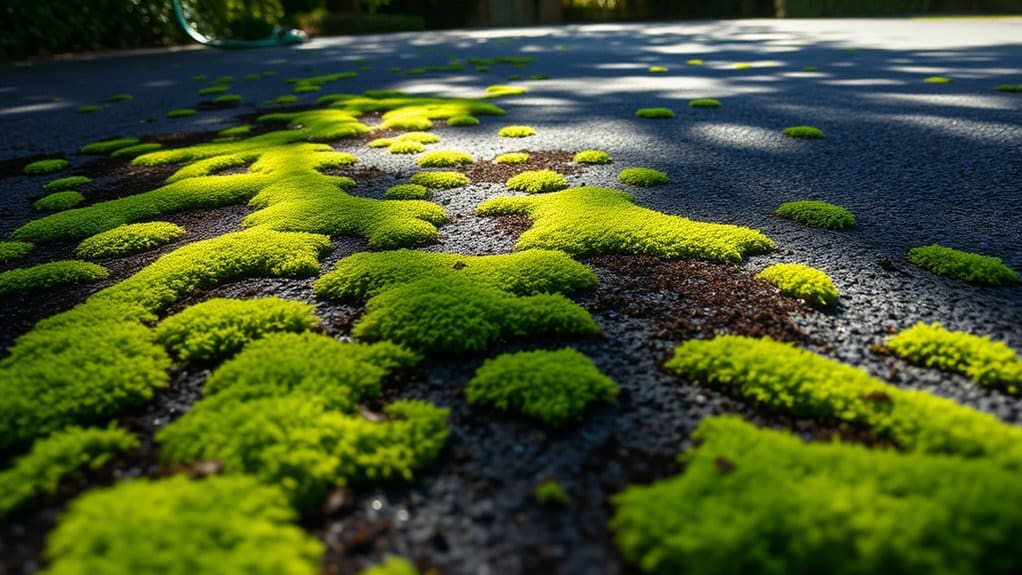
Moss and algae grow on tarmac driveways mainly due to environmental factors and the material’s characteristics. Frequent rain and inadequate drainage lead to moisture build-up, creating a perfect environment for algae. The uneven surface of tarmac, with its pores and cracks, traps water and promotes moss growth. Areas shaded by overhanging trees or parked cars limit sunlight, allowing moisture to linger and encouraging these organisms to thrive. Organic debris, such as leaves, can also collect and support moss and algae proliferation. Without regular maintenance, these elements come together to create a damp, sheltered space where moss and algae can flourish, affecting both the appearance and safety of your driveway. Additionally, ensuring driveways receive adequate sunlight exposure is key to preventing moss growth. Regular inspections and prompt removal of weeds can further mitigate the conditions that foster moss and algae.
Manual Removal Techniques
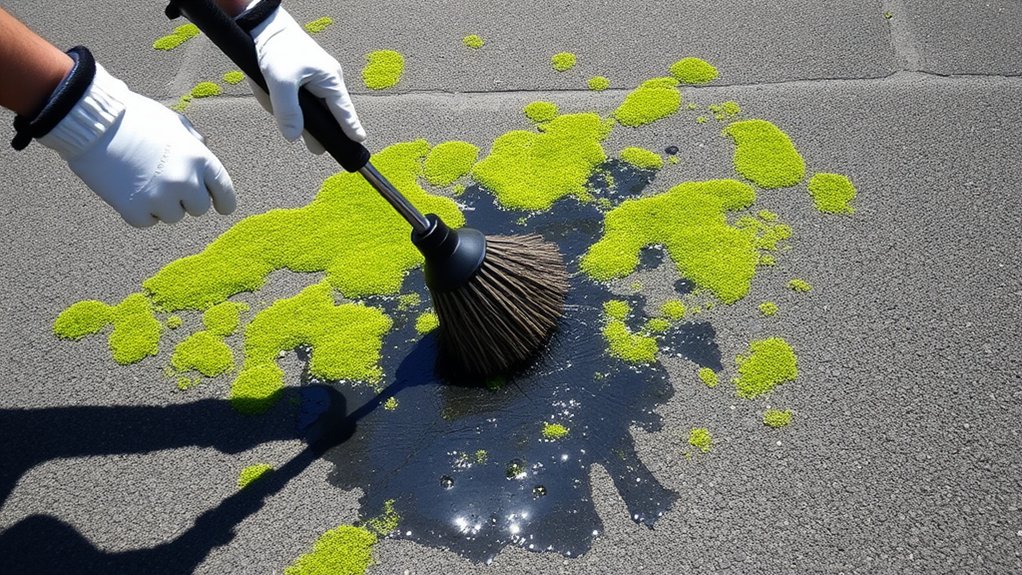
To effectively remove moss from your driveway, start by gathering the necessary tools: wire brushes, stiff brooms, and flat-edged shovels. Wet the moss first to make it easier to remove, then work through a simple step-by-step process for a thorough clean. Regular maintenance is crucial for tarmac surfaces, as it helps prevent moss growth in the future. Implementing regular inspections of your driveway can further aid in detecting early signs of moss before it becomes a problem. Use consistent patterns and firm pressure to achieve the best results, and pay close attention to detail as you go.
Tools for Manual Removal
When removing moss from your driveway, having the right tools is essential for a successful job.
Start with stiff-bristled or wire brushes, which are perfect for dislodging moss without harming the tarmac. You might also find specialised scrapers for tarmac helpful in tackling stubborn patches. For initial cleaning, use a stiff-bristled broom to sweep away loose debris. Brush-shredder tools can be effective as they combine brushing and debris removal in one go.
Additionally, consider that controlling moisture can significantly help in preventing future growth, so ensuring your tools are suited for the job is crucial. Don’t forget your safety gear—gloves, goggles, and masks are a must.
Take the time to compare tools to ensure you choose the best equipment for your moss removal needs, making the task easier and more efficient.
Step-by-Step Process
Begin by preparing your driveway for effective moss removal. First, wear protective gear such as gloves, goggles, and a mask.
Identify affected areas by examining the surface closely, then sweep away dirt and organic debris. Dampen the moss to make it easier to scrape off.
Use stiff-bristled brushes and flat-edged shovels, applying consistent pressure for effective removal. Address moisture issues by improving drainage and trimming nearby plants to allow more sunlight.
For stubborn patches, consider using a bleach solution or vinegar alongside manual removal methods. After applying any solution, scrub the area and rinse thoroughly.
Regular maintenance, including sweeping and inspections, will help prevent future moss and algae growth.
Chemical Removal Options
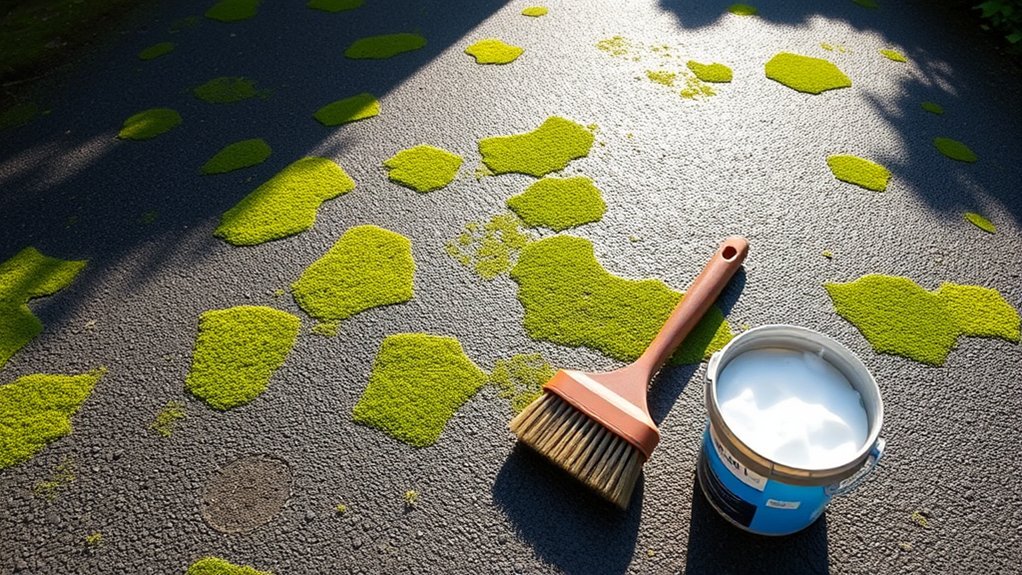
Chemical removal options for moss and algae on tarmac driveways provide effective solutions for homeowners dealing with stubborn growth.
Before using these treatments, ensure you assess product safety to protect the environment. Here are some popular options:
- Commercial moss killers such as Batiface or HG Algae & Mould Remover are effective if left to work for 30 minutes.
- Jeyes Fluid, when diluted and applied for 15 minutes, effectively kills moss.
- Bleach solutions (1:4 ratio) can disrupt moss growth, but use with caution around plants.
- Green CLEAR, a microbiological product diluted at 5:1, effectively targets algae.
For the best results, follow application instructions carefully, including allowing adequate dwell time and rinsing afterwards.
Natural and Eco-Friendly Solutions
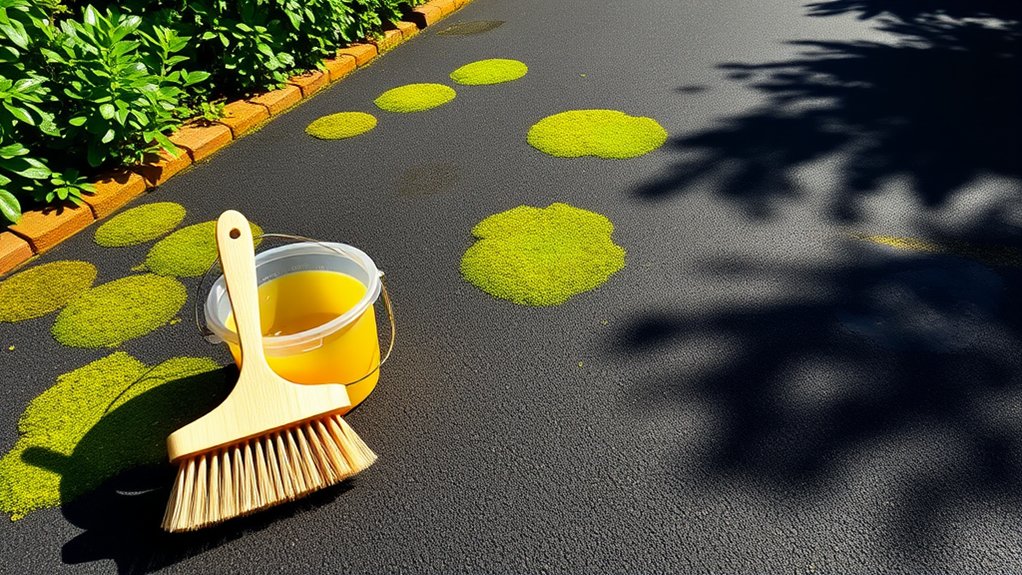
To effectively remove moss and algae from your driveway, try using baking soda to adjust the pH, which can help prevent regrowth.
Pressure washing is another great option; it clears away unwanted growth without the need for harsh chemicals, making it a safer choice.
Lastly, ensure your driveway gets enough sunlight. Trim back any overhanging trees and keep drainage clear to create conditions that are less favourable for moss to thrive.
Baking Soda Application
Baking soda provides three effective methods for removing moss and algae from your driveway: the powder method, paste method, and spray method. Each technique leverages baking soda‘s properties to combat moss growth effectively.
- Powder Method: Simply sprinkle dry baking soda directly onto the moss and leave it for a few days.
- Paste Method: Mix baking soda with a bit of water to form a paste, then apply it to the affected areas for targeted treatment.
- Spray Method: Combine baking soda and water in a spray bottle and apply it to the areas needing attention.
For best results, apply during cooler, damp conditions.
Regular application at least twice a year helps prevent moss growth and creates an unfavourable environment for future spores.
Embrace this non-toxic, eco-friendly solution!
Pressure Washing Benefits
When it comes to maintaining your driveway, pressure washing is an effective method for tackling moss and algae. This approach not only cleans away dirt and stains but also boosts your home’s appearance.
Regular pressure washing serves as preventative maintenance, helping to avoid costly repairs by preventing cracks and deterioration. It’s environmentally friendly, relying on water rather than harsh chemicals, which helps protect local water quality. Additionally, using a low-pressure setting during the process can help prevent damage to the tarmac surface.
Plus, it enhances safety by removing slippery mould and algae that can lead to accidents. Overall, pressure washing prolongs the life of your driveway while promoting a cleaner, safer environment.
Sunlight Exposure Techniques
Pressure washing is an excellent way to maintain your driveway, but maximising sunlight exposure can help prevent moss and algae growth even further. Sunlight dries out these organisms, which prefer shady, damp environments.
Here are some simple techniques to enhance sunlight exposure:
- Trim back overhanging branches and shrubs to reduce shade.
- Move any items that block sunlight from mossy areas for better direct exposure.
- Keep an eye on your driveway to prevent moisture build-up.
- Ensure proper drainage to avoid damp conditions that encourage moss growth.
Effective Pressure Washing Methods
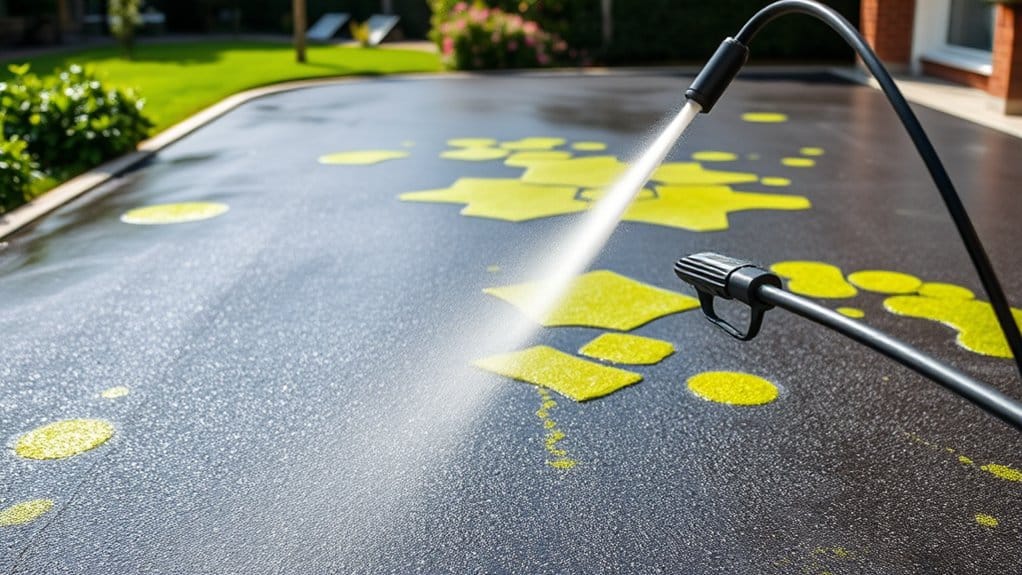
To effectively remove moss and algae from your driveway, it’s essential to use the right pressure washing techniques suited to your surface. Start by choosing the appropriate pressure washer and nozzles. For tarmac, opt for a 40° or 45° nozzle to avoid causing damage. Keep a safe distance and use sweeping motions for an even clean.
| Nozzle Type | Recommended Pressure Washer | Key Benefits |
|---|---|---|
| 0.045 Nozzle | 30 L/min | Ideal for tough stains |
| 40° or 45° | All standard washers | Prevents striping |
| Tapered Nozzle | Various types | Easy to secure |
Be sure to rinse the tarmac after washing to stop residue from building up and to achieve a spotless finish.
Preventive Measures to Avoid Future Growth
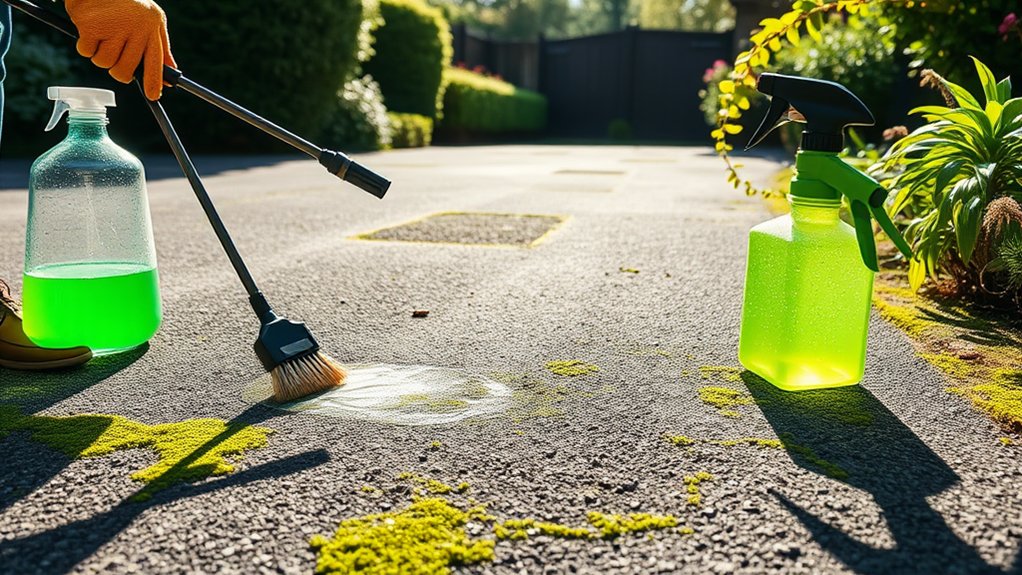
To prevent moss and algae from growing on your driveway, it’s important to adopt some straightforward maintenance practices.
Here are a few effective measures:
- Trim Vegetation: Regularly cut back overhanging trees and bushes to allow more sunlight to reach the driveway.
- Improve Drainage: Ensure your driveway has adequate drainage to stop water from pooling.
- Regular Cleaning: Sweep the driveway often to clear away leaves and debris that can encourage moss growth.
- Apply Moss Inhibitors: Consider using products like Floorseal Green Remover to prevent regrowth.
Frequently Asked Questions
Can I Use Vinegar to Prevent Moss From Returning?
Yes, you can use vinegar to prevent moss. Its acetic acid content disrupts moss growth effectively. Regular applications can help keep your garden or patio moss-free, ensuring lasting results and warding off future infestations.
How Often Should I Clean My Driveway to Prevent Moss?
Cleaning your driveway twice a year can significantly minimise moss growth. It’s wise to set up a regular cleaning routine, particularly in shaded areas or spots with heavy foot traffic. This will help maintain the surface condition and extend its lifespan.
Will Moss Damage My Tarmac Driveway Over Time?
Yes, moss can damage your tarmac driveway over time. If you ignore maintenance, moss can grow in cracks, weakening the structure and creating slippery surfaces. This can lead to expensive repairs and a shorter lifespan for your driveway if not dealt with quickly.
Is It Safe for Pets to Walk on Treated Areas?
As a responsible pet owner, prioritising your pet’s safety is essential. After a treatment, ensure your pets stay away from the area to prevent exposure to chemicals. Always check that the surface is dry and safe before letting them back on it. For example, if you’ve had your garden treated for pests, wait until the grass is completely dry and any chemicals have had time to dissipate before allowing your dog to roam freely.
Can I Mix Different Removal Methods for Better Results?
Yes, combining different removal methods can improve effectiveness. However, be cautious of potential chemical interactions, as some mixtures might damage surfaces. For instance, mixing bleach and vinegar can create toxic fumes. Always compare the effectiveness of methods to ensure safe and efficient results without harming your materials.
Conclusion
In summary, keeping your tarmac driveway clear of moss and algae not only improves its look but also prolongs its life. With several removal options available, there’s no need to let the problem escalate. Whether you choose manual methods, chemical treatments, or natural solutions, regular cleaning is key. A clean driveway boosts your property’s value and shows you care about its maintenance.
Maximize the durability of your tarmac driveway by understanding the ideal weather conditions for installation—discover the secrets to perfect timing Read more
Discover the common causes of tarmac driveway cracks and learn effective repair methods to protect your investment—your driveway deserves the Read more
Before you paint your tarmac driveway, discover essential tips and techniques that can transform its appearance and durability—don't miss out Read more

